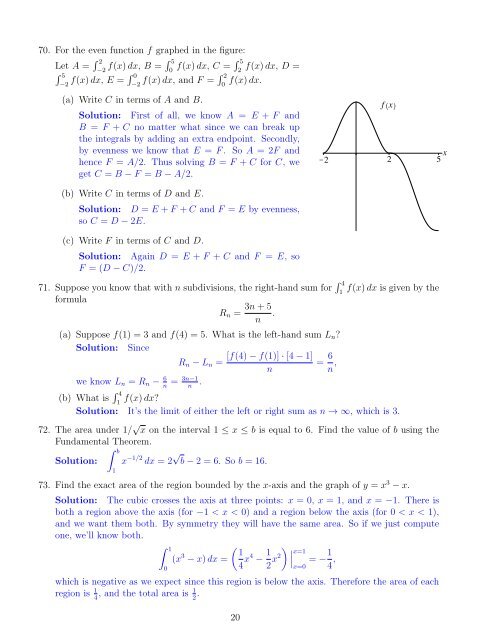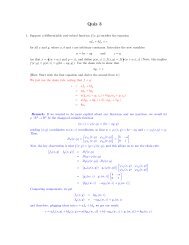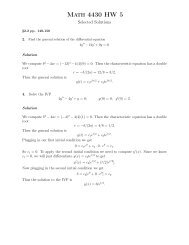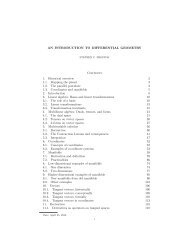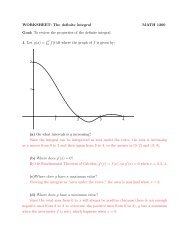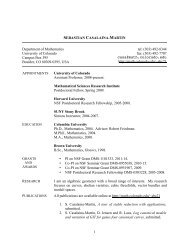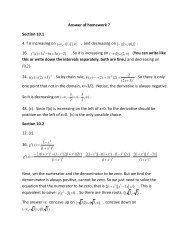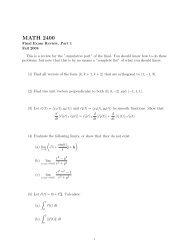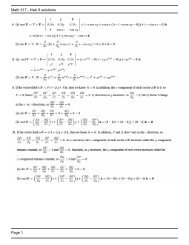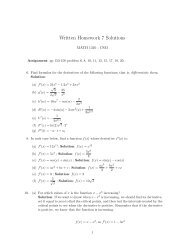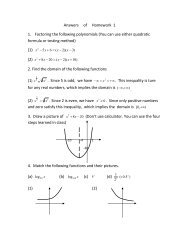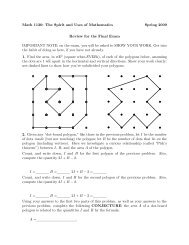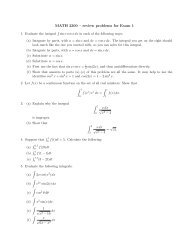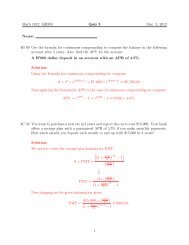Answers to Review Sheet for Final Exam
Answers to Review Sheet for Final Exam
Answers to Review Sheet for Final Exam
You also want an ePaper? Increase the reach of your titles
YUMPU automatically turns print PDFs into web optimized ePapers that Google loves.
70. For the even function f graphed in the figure:<br />
Let A = 2<br />
−2 f(x) dx, B = 5<br />
0 f(x) dx, C = 5<br />
f(x) dx, D =<br />
2<br />
5<br />
−2 f(x) dx, E = 0<br />
−2 f(x) dx, and F = 2<br />
f(x) dx.<br />
0<br />
(a) Write C in terms of A and B.<br />
Solution: First of all, we know A = E + F and<br />
B = F + C no matter what since we can break up<br />
the integrals by adding an extra endpoint. Secondly,<br />
by evenness we know that E = F . So A = 2F and<br />
hence F = A/2. Thus solving B = F + C <strong>for</strong> C, we<br />
get C = B − F = B − A/2.<br />
(b) Write C in terms of D and E.<br />
Solution: D = E + F + C and F = E by evenness,<br />
so C = D − 2E.<br />
(c) Write F in terms of C and D.<br />
Solution: Again D = E + F + C and F = E, so<br />
F = (D − C)/2.<br />
71. Suppose you know that with n subdivisions, the right-hand sum <strong>for</strong> 4<br />
f(x) dx is given by the<br />
1<br />
<strong>for</strong>mula<br />
3n + 5<br />
Rn = .<br />
n<br />
(a) Suppose f(1) = 3 and f(4) = 5. What is the left-hand sum Ln?<br />
Solution: Since<br />
[f(4) − f(1)] · [4 − 1]<br />
Rn − Ln = =<br />
n<br />
6<br />
n ,<br />
we know Ln = Rn − 6 3n−1 = n n .<br />
(b) What is 4<br />
f(x) dx?<br />
1<br />
Solution: It’s the limit of either the left or right sum as n → ∞, which is 3.<br />
72. The area under 1/ √ x on the interval 1 ≤ x ≤ b is equal <strong>to</strong> 6. Find the value of b using the<br />
Fundamental Theorem.<br />
Solution:<br />
b<br />
1<br />
x −1/2 dx = 2 √ b − 2 = 6. So b = 16.<br />
73. Find the exact area of the region bounded by the x-axis and the graph of y = x 3 − x.<br />
Solution: The cubic crosses the axis at three points: x = 0, x = 1, and x = −1. There is<br />
both a region above the axis (<strong>for</strong> −1 < x < 0) and a region below the axis (<strong>for</strong> 0 < x < 1),<br />
and we want them both. By symmetry they will have the same area. So if we just compute<br />
one, we’ll know both.<br />
1<br />
0<br />
(x 3 − x) dx =<br />
<br />
1<br />
4 x4 − 1<br />
2 x2<br />
x=1<br />
= −<br />
x=0<br />
1<br />
4 ,<br />
which is negative as we expect since this region is below the axis. There<strong>for</strong>e the area of each<br />
region is 1<br />
1<br />
, and the <strong>to</strong>tal area is 4 2 .<br />
20


